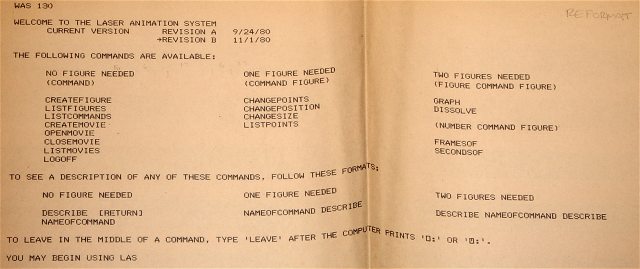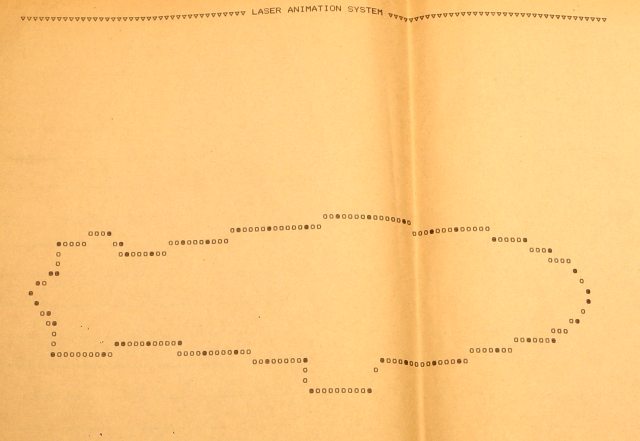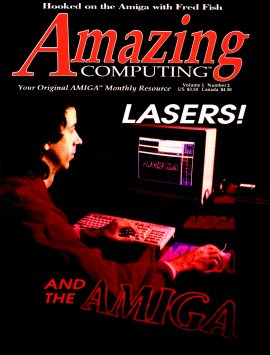![]()
I worked out of the mainstream for the first decade of my laser work, during the 1980s. Only in 1990, at the ILDA meeting in Bradenton Florida, did I "come out of the closet" so to speak, when Bill Benner and I showed the first commercial version of Pangolin's laser show design software.
For good or bad, this isolation had an effect in that Pangolin didn't always do things the same way as more established laser companies. But I am getting way ahead of the story...
I first became hooked on lasers during a 1979 physics class at Oberlin College. The professor set up a HeNe, turned out the lights, and clapped eraser dust in the beam. The thin, sparkling beam was entrancing.
I bought a Metrologic laser and started to play around with it, to see what it could do. The Metrologic catalog insert "100 things to do with a laser" was very useful. While on a semester break, I attended my first Laserium concert, in St. Louis.
I also began learning about laser displays, which was difficult in the pre-Internet era. I eventually found out about Lovelight, General Scanning's cloud-writing, Laser Displays and others doing representational images. I wanted to do the same with the more limited resources available to me.
Luckily, Oberlin had one of the very few laser galvo systems available to undergraduates at the time. It belonged to the electronic music department, called TIMARA ("Technology In Music And Related Arts").
In the mid-1970s, a TIMARA professor named Ron Pellegrino put together an open-loop HeNe laser projector. He used it for electronic music visualization. He left in 1978, a year before I got there. In 1981, Pellegrino published a book based in part on his laser/music work, The Electronic Arts of Sound and Light. One chapter is entitled "Laser Light Forms".
TIMARA's laser projector was literally gathering dust when I became interested in using it to see electronic music output. With the help of TIMARA engineer John Talbert, my friend Roger Lippincott (later to work for AVI), and others, the laser projector was revived. The main signal source for the projector was TIMARA's large Moog Modular synthesizer.
With such a powerful synthesizer generating complex signals, it was easy to do Laserium-type abstract images. The trick was to do representational images such as logos and words.
My first representational image was a flag done with 8 (!) points -- two for the flagpole and six for the flag itself. It was done using an analog Moog 960 sequencer module that looked like this:
There were 8 steps with 3 voltage sources per step. The top row of knobs became the X-axis signal; the middle row became the Y-axis. (The projector did not have blanking or "Z-axis" control, so the bottom row of knobs was not used.)
It was kind of fun drawing with it. Have you ever taken a piece of string, laid it on a table, and then moved it around with your fingertip to make different shapes? The analog sequencer worked much like that. In this case, there were 8 "fingers" that could be used to shape the laser "string". To make the flag wave, I could turn knobs simultaneously in real-time.
Oberlin had a second sequencer module, so I later made 24-point images by slaving the two 8x3 modules together. (One module was set to run sequentially through the 24 knobs to control the X-axis; the other module ran through its 24 knobs to control the Y-axis.) This was the limit of drawing complexity with the analog equipment available to me.
For purely digital images, I used TIMARA's computer music system. It ran on the College's Xerox (SDS) Sigma 9 mainframe, featuring 128K of memory and a whopping 0.5 GB of disk storage. The programming language was APL, a math-based language perfect for manipulating strings of numbers like those used for X and Y coordinate data. The computer could output waveforms through four 15-bit D/A's, at a default rate of 10,240 points per second.
Using APL, I wrote my first Laser Animation System. It was text-based of course, and had about a dozen commands for creating frames (I called them "figures") and animations (I called them "movies"). You could even morph between two figures using the Dissolve command. Here's a printout of the commands as they were in November 1980:

Although I was the only one using LAS, even then I was into user-friendliness. It had a primitive help system where the "Describe" command would give you a description of the other commands.
Incidentally, the first commercial Pangolin system, LSD256, was the eighth in a series of programs that date back to the LAS shown here. (Anyone remember the climax of the movie TRON, where the sinister Master Control Program turns out to have an ancient chess program at the core?)
The first digital laser animation I did featured a blimp morphing into an explosion. Here's a printout of the point data for the blimp. It has 48 points, as shown by the darker black dots:

I couldn't afford a digitizing tablet, and I had no access to graphic computer interfaces. Therefore, "digitizing" was done by drawing the image on a sheet of graph paper, manually figuring out the points' X and Y coordinates, and writing them down. Later the list was typed into the computer. I used this manual system until about 1986, when I wrote my first mouse-driven computer drawing system.
As I said, I was lucky at Oberlin. Since no one else was into lasers, I got to keep the projector and some analog generators in my dorm room. I bought other HeNes, built lumia and speaker-based effects, and did laser shows all the time in the dorm. Others might call this partying but for me it literally was studying (not that there wasn't some of the other going on as well...). This also got some other people hooked on lasers, most notably my high-school friend David Lytle. He and I started a company together; David later became editor of The Laserist magazine and executive director of the International Laser Display Association.
After graduating from Oberlin in 1981, I bought a Radio Shack TRS-80 Model 1, and wrote a menu-driven computer graphics system. Roger Lippincott built the D/A converter box for the TRS-80, which we called "the Lippintron". This system was used for occasional commercial laser shows and art exhibits, done by Roger, David Lytle and myself under the name "Nightlight Laser Design Studio".
By 1985 I grew tired of doing shows. I wanted to concentrate on the software aspect of my laser work. I therefore undertook a cross-country trip to research commercial laser graphics systems. At that time, there were expensive Laser Media-type systems, and relatively affordable Apple II-type systems ("only" $8000), but nothing had the features I was looking for.
On the flight back from my trip, I read an article in Byte magazine about a brand-new computer called the "Amiga". It was very exciting that this computer had two built-in D/A converters for making stereo music (a.k.a. X and Y laser signals). I soon bought my first Amiga 1000 and began work on a mouse-driven computer drawing system. In February 1988, I wrote a cover article for an Amiga magazine about my system, which I called the "MCP" after the TRON computer. In the article, I mentioned my frustration with having only two D/A channels, so I couldn't do blanking -- note the non-blanked "Amiga" logo in the cover photo:

Incidentally, this photo is a single frame of 35mm film, photographed by double exposing the background image plus the "Amiga" logo being projected on translucent cloth. The projector is just to the right of the computer monitor. (The words "AND THE" were added along with the other type on the cover, by the Amazing Computing graphics department.)
A brilliant engineer working at the Daytona Beach planetarium, named Bill Benner read the Amazing Computing article and tracked me down. Not only did he also use the Amiga for lasers, he had already built a four-channel D/A modification called the "QuadMod". Bill thought my graphic user interface software might be useful with his QuadMod hardware board. But you already may have heard the rest of that story!
![]()
Laser Displays Inc.
Laserium
Patrick Murphy (pre-Pangolin)
Laserist List histories
Links to other lasershow history websites